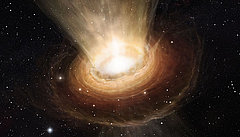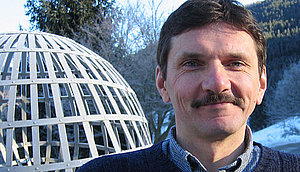uni:view: Mister Chruściel, what is your reaction to the Nobel Prize in physics awarded to the three scientists Rainer Weiss, Barry C. Barish and Kip S. Thorne?
Piotr Chruściel: I cannot think of a Nobel Prize in physics more deserved than this one. The direct observation of gravitational waves provides the most beautiful confirmation so far of Einstein's theory of general relativity. The discovery is a monument to Einstein, to the power of the human brain, to our ingenuity in pushing technology to unprecedented limits: the precision required in the measurement of the gravitational waves is identical to that needed to detect the change of distance of Saturn from our sun by the diameter of a hydrogen atom.
When Einstein discovered that his theory predicts gravitational waves, he calculated their intensity and wrote that we will never be able to measure them. Well, the Laser Interferometric Gravitational Observatory (LIGO) did it. And without Barish, Thorne, and Weiss, there would have never been a LIGO.
uni:view: What is the scientific significance of the research of Rainer Weiss, Barry C. Barish und Kip S. Thorne – and the importance for humans?
Chruściel: Detection of gravitational waves will not affect our everyday life in a foreseeable future. This is similar to most results in basic science, which provide the background for our understanding of the world. One can think here of foundations of a house: they are rarely seen, but houses without foundations will topple before long.
Did the discovery of the Higgs boson, a few years back, change our life? It did not, but without it we wouldn't be sure that the standard model of particle physics is correct.
We have been confident, since the late 1980's, that gravitational waves exist. The Nobel Prize in 1993 has been awarded to Hulse and Taylor, the discoverers of a pulsar whose motion was witness to existence of waves as predicted by Einstein's theory of gravitation. This gave us an indirect confirmation, now we have a direct one.
But this is only the tip of the iceberg. The first detection provided us with three new black holes for the price of one: two black holes before merger, and a post-collision one. The masses of these black holes, about 30 and 35 solar masses before the collision, and about 60 solar masses for the final black hole, were larger than any other stellar-size black holes observed, and predicted to exist. The subsequent observations of black hole collisions (and we have four up-to-date) confirmed the existence of many such black holes. This is a revolution in astrophysics, where we can now observe the sky using gravitational waves, and see things that are undreamed-of with optical or X-ray astronomy. And we are discovering new objects in the sky as we go.
There is of course the vertiginous question, are there limits to our understanding of nature, of physics, of the universe? The LIGO detections are pushing the boundaries of human vanity further than ever.
uni:view: Have there been – former – scientists of the University of Vienna involved?
Chruściel: LIGO has two faces. The first one is the instruments themselves, which provide the data. The second is the LIGO Consortium, consisting of about 1.000 scientists worldwide, whose task is to analyze the data. University of Vienna has indirect ties to the Consortium, through former students: Sacha Husa, a PhD graduate from University of Vienna and currently Professor at the Universitat de les Illes Balears, has helped to develop numerical tools needed to analyze and interpret the huge stream of data flowing out of the LIGO detectors.
Similarly for Michael Puerrer, who is currently working at the Albert Einstein Institute for Gravitational Physics in Potsdam. We are further very happy that another of our students, Patricia Schmidt, currently at Radboud University in Nijmegen, has actively participated in the analysis of the LIGO data. Sascha, Michael and Patricia are co-authors of the landmark papers announcing and describing all four gravitational wave detections so far.
In this context one should not forget about Sir Hermann Bondi, born in Vienna in 1919, who passed away in 2005 after an illustrious scientific career amongst the spires of Cambridge Colleges. He is widely recognized as the researcher who set the ground for the theoretical understanding of gravitational radiation, and would have been one of the recipients of the prize if still alive.
YouTube "LIGO"
uni:view: You yourself are an expert in the field of Gravitational waves. What does this Nobel Prize mean for your own research?
Chruściel: General relativity (GR) is a demanding subject, drawing on all of physics, and on many mathematical tools. As a consequence, not many physicists have a working knowledge of the field, and therefore the GR community is (relatively) small. LIGO and other GR achievements (e.g., the discovery of the accelerated expansion of the universe) are arousing interest in the field, and so one can hope for more academic positions for young colleagues interested in GR.
I was very pleased to see last year the doubling of the number of students attending my lectures on general relativity. This was without doubt related to the LIGO observations. There is clearly a need amongst students to be introduced to the field, and I together with the members of my group will be happy to provide. Needless to say, the associated teaching load further increases the pressure on the number of academic jobs.
Big science needs big funding, and the LIGO observations should bring new financial life to projects such as the Einstein telescope, a proposed third-generation ground-based gravitational wave detector, currently under study, which will push further the detectability limits for the waves. Similarly we hope that the plans to build a new detector in Australia will be revived. A new detector in Australia will increase dramatically our ability to localize the origin of the signals.
uni:view: What are the differences and the similarities of your personal research from those of the Nobelprize winners?
Chruściel: The strength of the Vienna gravitational physics group is, and always was, the mathematical aspects of Einstein's theory of relativity. I and my colleagues, Peter Aichelburg, Bobby Beig, Walter Simon from the Physics department, or Michael Eichmair from the Department of Mathematics, to name a few, have clarified many aspects of black holes, gravitational waves, general relativistic stars, energy in general relativity, or the behaviour of gravitational fields in various regimes. These are paper-and-pencil studies, which provide solid mathematical foundations to experiments such as LIGO. But we stay away from the tremendous experimental efforts involved in setting-up the experiments, and running them, or the incredibly sophisticated numerical simulations needed to analyze and interpret the stream of data pouring-out of the detectors.
The University of Vienna has a contribution to future gravitational wave detectors through the discovery of new mirror coatings by Markus Aspelmeyer and his group. These low-noise reflective coatings will be used in the next upgrade of the LIGO instruments.
uni:view: What will the future hold in this field?
Chruściel: The LIGO and VIRGO instruments are there, new instruments are being built, and all those will be observing the sky for years to come. A satellite mission, the Laser Interferometric Space Antena, which will be observing gravitational waves in a different frequency band, is being prepared for launch by the European Space Agency. We have to be able to develop methods to analyze and interpret the resulting streams of data faster and better than what we can do today.
On the theory side, many mathematical aspects of gravitational waves beg further understanding. A seemingly simple question, such as stability of black holes under small perturbation, has been occupying tens of mathematical relativists for years, with a proof remaining elusive. Questions such as the change of gravitational wave forms under small changes of initial configurations of the gravitating systems are mathematical terra incognita, and need to be answered to obtain a satisfactory understanding of sources of gravitational waves.
I could add many further problems to the above, so please rest reassured that both experimentalists and mathematical relativists will have plenty to do in the coming years.
Last, but not least, astrophysicists have to explain now how black holes of 35 solar masses came to life. This is not an easy task within the existing scenarios of stellar evolution, which did not anticipate such a possibility.
uni:view: Thank you for the interview! (red)
| Since April 2010, Piotr Chruściel holds the professorship for Gravitational Physics at the Faculty of Physics. Prior to his affiliation with the University of Vienna he carried out research and taught in renowned institutions such as the University of Oxford and the Max Planck Institute for Gravitational Physics. (Photo: MFO) |







